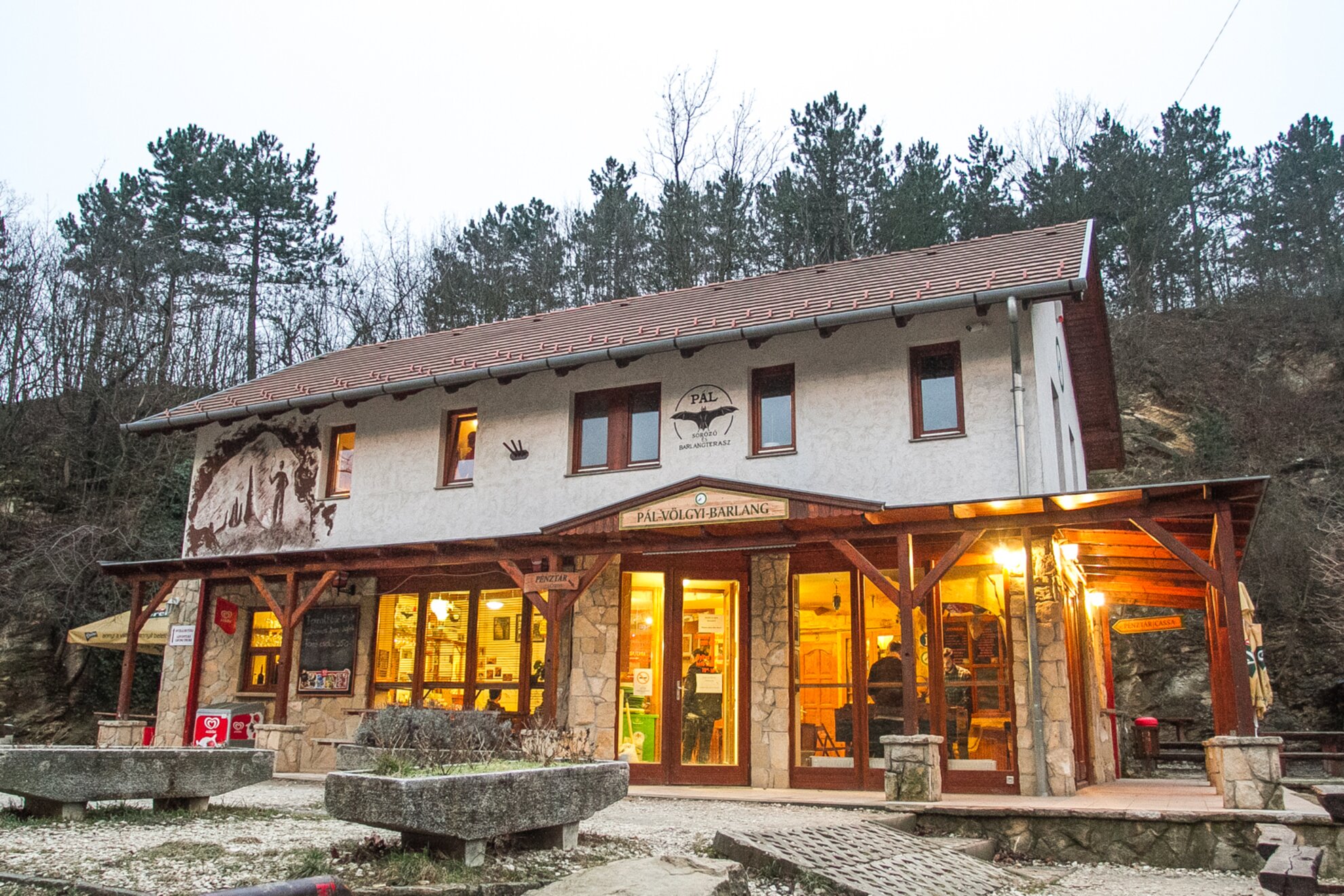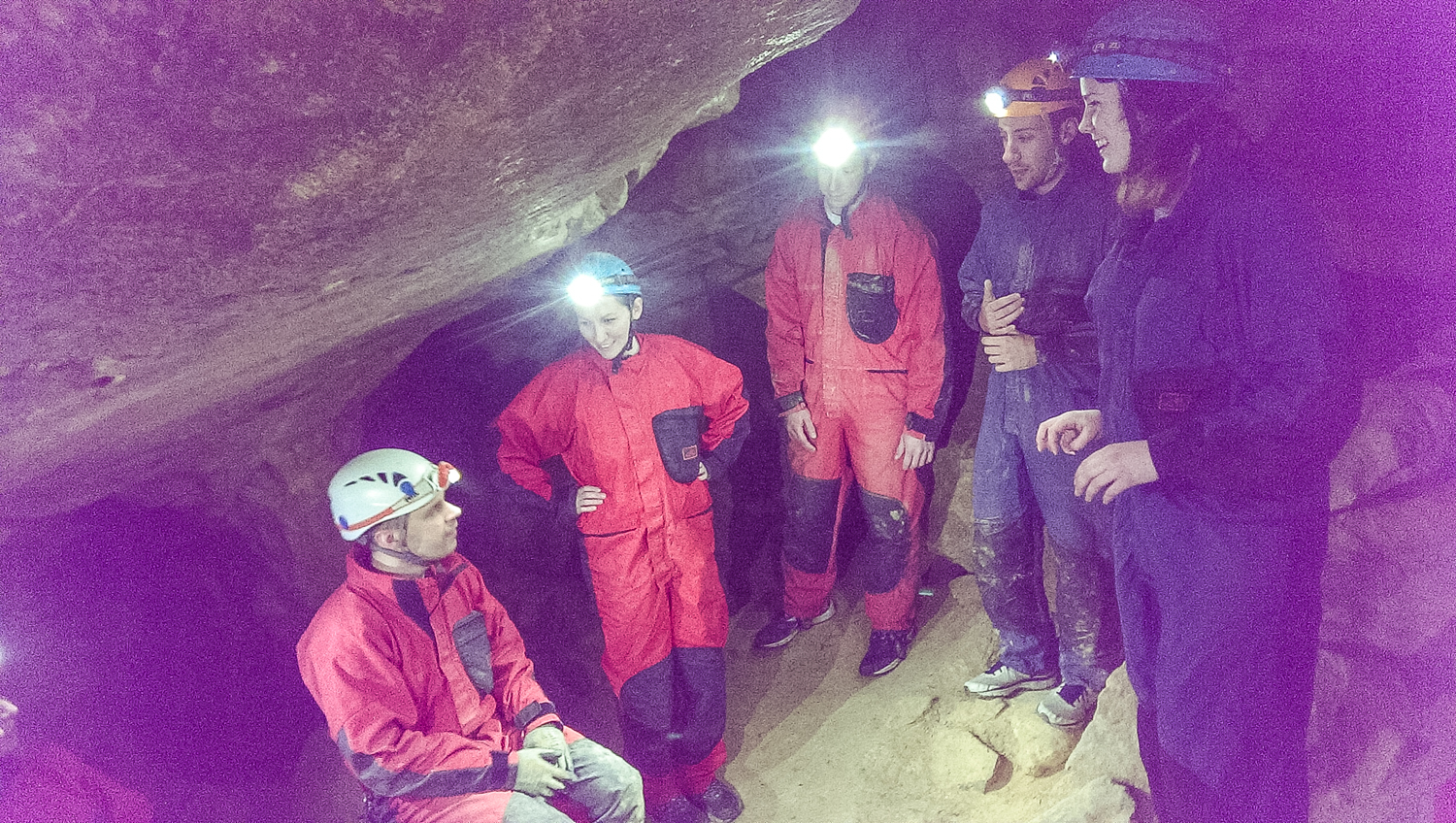Found alongside Szépvölgyi Avenue uphill from Óbuda’s Kolosy Square and easily accessible by bus 65, the Pál-völgyi cave system is part of Hungary’s Duna-Ipoly National Park, and its main entrance is located within Budapest’s borders just a quick trip away from the city center – although the subterranean passages extend over 30 kilometers from here.

Arriving at the charming Pál-völgyi visitors’ center (complete with a pub), we can choose between the easy 45-minute tour of a smoothly paved cavern with permanent lighting to illuminate amazing stalagmites and stalactites… or we can don protective coveralls and headgear before joining highly trained caving guides that lead physically demanding three-hour expeditions into the natural crevasses and crannies of the cave system starting on the other side of the canyon. Of course we opt for the more extreme experience, so here we are walking through the woods toward a sheer cliff that we’ll soon worm our way into, yet at this point we don’t realize just how much actual crawling will be involved.

Our captain for this journey is dedicated Magyar spelunker Laci Berecz, who’s been leading Pál-völgyi tours for 13 years in both Hungarian and English, while occasionally joining extended caving trips that pierce downward into the Alps – one time he ventured 960 meters deep on an underground mission lasting a full week. With a lighthearted and friendly spirit, Laci briefly explains some basic rules before unlocking the steel door at the grotto’s entrance; no caving experience is required to join this journey, but our guide’s hard-earned know-how will be crucial to traversing the sometimes-hazardous route, including deep chasms and precariously balanced overhead boulders.

We step into the reinforced first few meters of the cave and reach a small chamber where Laci offers more instructions and a few corny jokes about watching out for “cave monsters”, helping to diffuse the nervousness now apparent in the eyes of some excursionists. Our intercontinental team is comprised of a few Americans, three Belgian guys, and an Australian couple, and while none of us consider turning back now, the seriousness of this adventure becomes vividly apparent as we climb down a nine-meter-long steel ladder into the shadowy abyss.

At first the process of making our way through the rocky passages does not appear too difficult; the clay-like mud lining the floor is a little slippery, and some corridors require bracing our hands against the surrounding walls, but this is nothing too extreme – until Laci stops the group at another small chamber and reveals that now we will slide down a steep grade before reaching a section where the only way to pass is by lying on our bellies and inching ahead with our toes. Before we can fully process these directives, Laci darts rabbit-like through a tiny crevice and shouts with joy while audibly sliding a considerable distance; with no choice but to follow, we force ourselves through the same fissure and are soon gliding and tumbling deeper into the earth.

Crawling through a limestone tunnel less than three feet tall, we stave off thoughts of panic by noting the unique nature of Pál-völgyi’s geological structure – most surfaces are remarkably smooth throughout the cave system, as it was gently carved over eons by Hungary’s abundant thermal waters. The slow pace that we’re forced to adopt as we clamber between increasingly tight crannies allows us to notice beautiful details that formed alongside this stone maze at varied intervals, such as gleaming crystal formations and seashell fossils from millions of years ago, when the country was submerged under the prehistoric Mediterranean Sea.

Nonetheless, it’s a relief when we can stand fairly erect again and step into “The Theater”, one of Pál-völgyi’s many naturally created chambers that resembles some sort of manmade structure; here a hanging rock shelf is the curtain, a stony slope represents the seats, and a bumpy plateau is the stage. Laci happily points out that “The Theater” even has its own ghost – a protruding crag that does bear striking similarity to a face, especially when lit from behind to create a silhouetted visage.

At this point we’re 40 meters below the cave entrance, although we’re ‘only’ about 20 meters below a Buda residential zone on the surface; at some points we see the stringy bottommost roots of some apparently huge trees dangling from cracks in the ceiling. We’ll be heading downwards another ten meters before reaching the “Globe Room”, the deepest point in our tour – a somewhat spherical chamber crisscrossed with straight fissures reminiscent of latitude and longitude lines.

By now we’re getting exhausted, with bruised knees and elbows to prove the rigors of shimmying our way down to this depth, yet in a way the most strenuous part of our adventure is only just beginning – now we must scramble back up through another series of tight passages using rock-climbing techniques, only without the benefit of daylight to lead the way. Fortunately, Laci ever-energetically shows us how to take the next steps (often literally) as we navigate limestone junctures; if it weren’t for his guidance, we would surely be hopelessly lost by this point.

However, we soon return to “The Theater” and gratefully grasp our way back over familiar terrain toward the steel ladder leading heavenwards to outside civilization. Exhilarated by our strenuous accomplishment, we emerge into the night air grateful for Laci’s sure-footed leadership. Walking back through the canyon toward the eagerly remembered Pál-völgyi pub, our jumpsuits freshly streaked with mud and sweat, we truly feel like hardy explorers now.

Adventure-caving tours at Pál-völgyi begin at the visitor's center (Budapest 1025, Szépvölgy út 162) and cost 6,000 forints for adults and 5,000 forints for kids aged 6-14; all necessary equipment is provided for participants, but it is advisable to wear shoes that have traction and can get muddy, as well as wearing clothes with minimal buttons and zippers. Check out the official website for complete English-language details.




